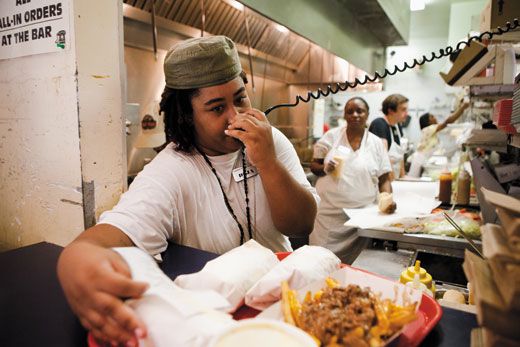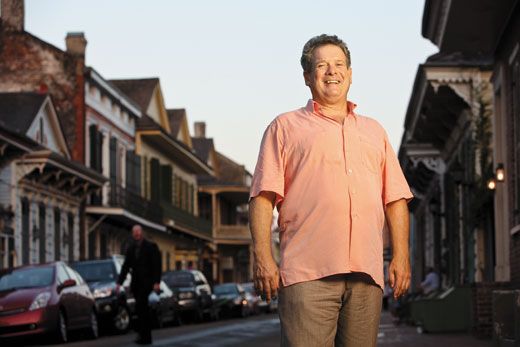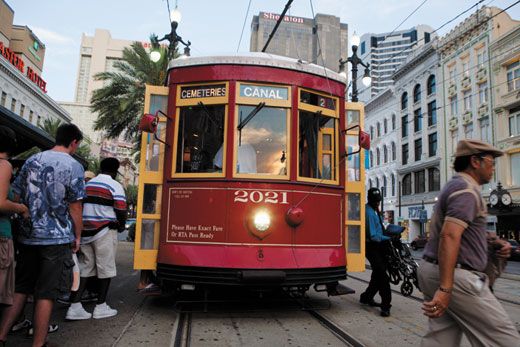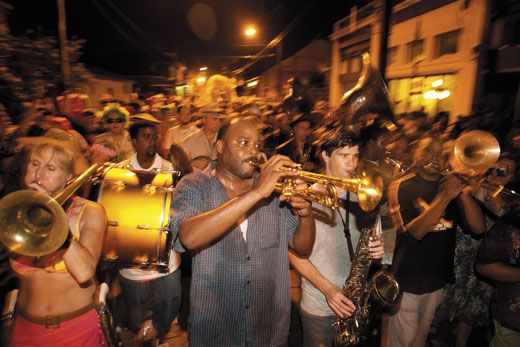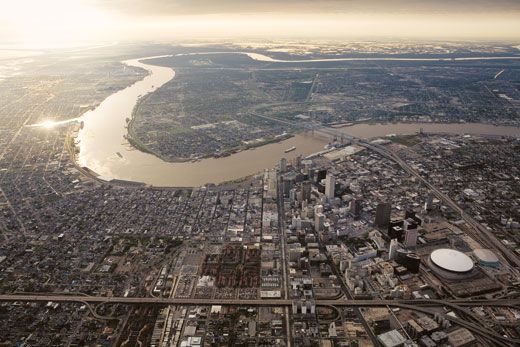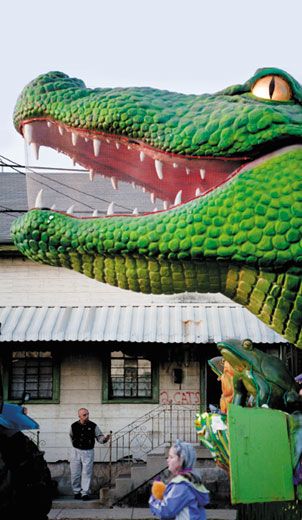New Orleans Beyond Bourbon Street
From out-of-the-way jazz joints to po’ boy shacks, a native son shares his favorite haunts in the Big Easy
Who can resist New Orleans? Gumbo and oyster po’ boys, jazz and funky blues, the French Quarter and the Garden District. Eyes light up, mouths water, toes tap. I’m obsessed with New Orleans—explaining its uniqueness to myself and to visitors. My need to understand the city is perhaps inescapable. When I was 15, my mother bought Chris Steak House with its small but loyal clientele. I bussed its 17 tables and learned how to butcher heavy short loins. Before long, Mom added her name, and the famous Ruth’s Chris Steak House chain of restaurants was born. Meanwhile, my father was making a name for himself too, running for mayor on a platform of bringing a gorilla to the New Orleans zoo. He got only 310 votes but kept his campaign promise by going to Singapore and buying two baby gorillas he named Red Beans and Rice. As the son of the Empress of Steak and the Gorilla Man, how could I not become a New Orleans obsessive?
I take friends on what I call the “Fertel Funky Tour,” meandering through sites the tour buses mostly miss. Once, some Parisian guests politely asked, “What ees thees ‘fun-kee’?” I explained that “funky” means smelly. Buddy Bolden, arguably the first jazzman of them all, played at the Funky Butt, a music hall named for his song that begs us to “open up that window and let that bad air out.” But funky also has come to mean the music played by groups such as the Funky Meters. Full of soul, it’s the kind of music you gotta dance to—unless there’s something wrong with you.
New Orleans is a Southern anomaly: in the South but not of the South, more Catholic (or pagan) than Baptist, as much Caribbean (or Mediterranean) as American. Almost everything here bears explanation, even how we orient ourselves. Because of the curve in the Mississippi River that makes us the Crescent City, we look to its West Bank for the sunrise. North Rampart is east of South Rampart. Since standard directionals are unreliable, we use our own: Lake Pontchartrain is on one side of the city; the Mississippi River on the other. Riverside and lakeside, Uptown and Downtown, as the river flows: those make up our compass rose.
In our checkerboard of neighborhoods, accents tell a tale Professor Higgins might appreciate. The frequently satirized Yat dialect—from “Where you at?” meaning “How are you?”—was influenced by Irish immigrants and sounds more Brooklyn than Southern. But just lakeside of Magazine Street, the Uptown gentry never say Yat, except in jest, and never say “New Orlins.” They say “New Awe-yuns.”
Gentry. Yes, we do share the South’s love of bloodlines. For almost a century, colonial New Orleans was stratified by parentage, a society of exclusion shaped by the aristocratic traditions of France and Spain. Canal Street—said to be the widest street in America—separated the mutual animosities of the French Quarter and the American Sector. New Orleans medians are still called “neutral grounds” after the Canal Street no man’s land that separated their rival domains.
That impulse to exclude didn’t stop with the French. The Pickwick Club is a social club whose Anglo-American membership has, since the mid-19th century, manned the old-line Mardi Gras krewes—the groups that create the parade costumes and floats. In 1874, Pickwickians led a volunteer militia to the Battle of Liberty Place that overwhelmed the metropolitan police and struck the blow that led to Reconstruction’s end and to Jim Crow’s birth. In 1936, my great-grandfather Sam, a pawnbroker known widely as Money-Bags Fertel, wanted to play pinochle at the Pickwick, whose clubhouse on Canal he owned. Denied membership as a Jew, he refused the Pickwick a new lease. In 1991, some krewes, challenged by the city council to admit blacks and Jews, chose to withdraw from public parading.
Our city is bedeviled by such ingrained hierarchies. In 2010, the Times-Picayune noted that an old-line krewe had chosen a “relative newcomer” as Rex, King of Carnival. The newbie was in fact an Uptown pillar of the community who had lived here for 37 years.
Nor is prejudice the province of whites alone. The black Creoles of New Orleans, many descended from the colonial aristocracy and their slaves or the free women of color they took as concubines, embraced some of the same biases. Not that long ago, black Creole clubs like the Autocrat tendered a “paper bag test”—anyone darker than a paper bag was turned away.
Yet New Orleans slaves, under the French and Spanish colonial law, fared better than those in English colonies. Allowed to congregate on Sundays, they held market, danced to native drums and sang their call-and-response chants. Congo Square, in the heart of Tremé, the Downtown neighborhood across from the French Quarter, was the center of their social and spiritual world. Now called Louis Armstrong Park, Congo Square is the ur-birthplace of jazz and a key stop on my Funky Tour.
My worst fear is that, unguided, visitors will seek out the “true” New Orleans on Bourbon Street: drunken frat boys, bad music and T-shirt shops. After Congo Square, the lower French Quarter is where I take my guests—quiet, residential eye candy wherever you look. On lower Chartres Street, the Ursuline Convent dates from 1752, the oldest surviving French colonial building as well as the oldest structure in the Mississippi River Valley. Nearby, wrought- and cast-iron railings line the balconies—we call them galleries—adding shade to sidewalks and outdoor space to second and third floors. The vernacular architecture of the French Quarter is in fact largely Spanish. When Spain controlled the city (1763 to 1800), two fires swept away the typical French colonial plantation-like homes.
Highbrow and lowbrow intermingle at lunch. Galatoire’s, that bastion of haute Creole cuisine, still requires a jacket for evenings and Sundays, even though its patrons must shoulder their way past strip clubs on Bourbon Street that call for only tassels on their dancers. On my tour, we lunch at the Parkway Bakery, which drew a thousand people when it reopened after Katrina. Most came for the roast beef po’ boy, a kind of terrestrial ambrosia.
On the lakeside edge of Tremé, I head for the crossroads of Orleans and Broad, where my mother’s flagship Ruth’s Chris once stood. (She died in 2002, my father in 2003. After Katrina’s flood, the corporation that now owns Ruth’s Chris relocated the restaurant near the Convention Center.) Here, the power elite once clinched their deals over 16-ounce rib-eyes drowned in butter, creamed spinach (my great-uncle Martin’s recipe) and generous martinis. When things got rowdy, Mom would take her servers aside and warn, “Easy on the drinks, girls, easy on the drinks.”
Catty-corner from where the original Ruth’s Chris stood lies the Zulu Social Aid and Pleasure Club, the black Mardi Gras krewe that Louis Armstrong once proudly presided over as king. Across the street at F&F Botanica, my visitors ogle gris-gris jars filled with magic powders.
The Fertel Funky Tour then lands on South Rampart Street, which once housed the pawnshop of my immigrant great-grandparents, Sam and Julia Fertel. In the early decades of the 20th century, their world was an odd mixture—a claustrophobic, Orthodox Jewish mercantile enclave and the epicenter of a musical whirlwind. At the corner of Perdido and Rampart, in 1912, a young boy was arrested for firing a weapon and sent to the Colored Waifs’ Home where he learned to play the cornet. Little Louis Armstrong later bought his first cornet, one door off that same corner, from Jake Fink, whose son Max, a jazz musician of note himself, married my great-aunt Nettie.
At that time, South Rampart Street sat on the edge of Back o’ Town, with hundreds of joints saturated in music, booze and vice. These Uptown musicians drew upon an African musical template and preferred improvisation to written music.
While jazz was aborning Uptown in Back o’ Town and South Rampart, the Downtown black Creole musicians in Tremé, having been trained in the orderly traditions of European classical music, disdained Buddy Bolden’s “ratty” sounds. Separated geographically only by Canal Street, the Uptown and Downtown musicians hailed from different cultures and different worlds. But when Uptown greats such as Armstrong came into their own, Creoles could no longer look down their noses at them. As musicologist Alan Lomax put it, marrying the “hot blasts from black Bolden’s horn” with “searing arpeggios from light [Lorenzo] Tio’s clarinet burned away the false metal of caste prejudices.”
Visitors on the Funky Tour enjoy the fruits of that marriage at the Thursday gig of Kermit Ruffins and the Barbecue Swingers at Vaughan’s, a Downtown dive in Bywater—his band so named because trumpeter Ruffins often brings his grill and serves ribs and red beans during the break. On Fridays, we travel a bit farther Uptown to Snug Harbor to hear the cooler contemporary jazz stylings of pianist Ellis Marsalis, father to four great jazz musicians and teacher to many more.
In such musicians you can hear the jazz marriage of Uptown and Downtown, high-toned and down-low funky that reshaped American and world culture. My visitors are drawn to New Orleans to pay homage to that union. Still heard in joints all over town, that music, at once heavenly and earthy, makes me forever proud to be both from and of New Orleans.
Randy Fertel’s memoir, The Gorilla Man and the Empress of Steak, comes out next month.
Planning Your Next Trip?
Explore great travel deals
Smithsonian magazine participates in affiliate link advertising programs. If you purchase an item through these links, we receive a commission.
